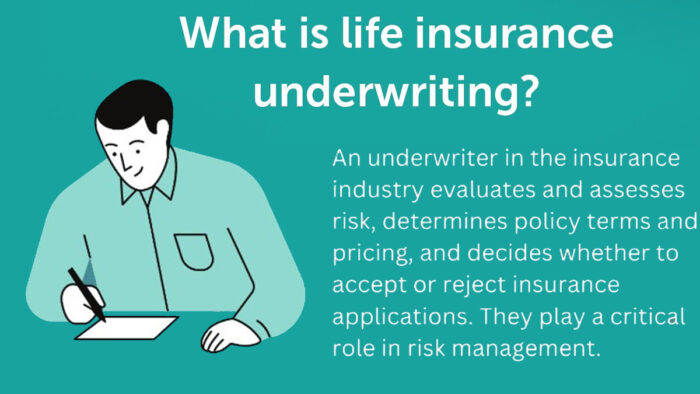Life insurance underwriting is a process in which an insurance provider reviews and assesses the risk involved with offering coverage for a person’s life and determines the rate of premium for the quote.

The process also involves evaluating different factors like the applicant’s occupation, age, lifestyle, medical history, and overall health. All of the factors are considered to determine the premium rate of the quote and find out the possibility of them passing away during the term of the policy.
How Does It Work?
Life insurance underwriting works by putting together information about the applicant’s health, lifestyle, and other important factors to evaluate their risk profile. All of the information is used to find out if they are worthy of the policy, therefore approving the application, denying it, or offering protection with specific conditions at high premium rates.
Here is an overview of how the entire process works. The first thing you need to do is apply. Once you apply for this procedure, you will undergo a medical examination. Then, you will provide your medical records, and the insurance company will assess your risk factors. In other words, they will find out if you are a low-risk or high-risk individual. Finally, the underwriting decision will be made.
Types of Life Insurance Underwriting
There are different life insurance underwriting processes because they differ by quote. Here are the main types of underwriting processes for life insurance:
• Financial Underwriting
Financial underwriting in life insurance is a procedure in which an applicant’s financial status or situation is assessed and evaluated to determine the risk they pose and fix a fair premium rate for a life insurance policy. Your financial documents and information will be reviewed during this underwriting process.
• Medical Underwriting
As for the medical underwriting process, the medical history and health of the applicant will be evaluated and assessed to determine the premium rates and policy coverage. The underwriter can then provide coverage for the policy if the applicant is qualified.
Factors to Consider During Life Insurance Underwriting Process
What are the risk factors that underwriters look for during the underwriting process? This is a very important question that you need to know the answer to. Here is a list of factors that will be considered and evaluated when an insurance company is conducting the underwriting process:
- Height
- Age
- Health condition
- Weight
- Lifestyle habits
- Occupation
- Family medical history
- Military service
- Driving record
- Hobbies
- Credit standing
- Gender
- Alcohol use
- Policy type
- Financial information
- Coverage amount
- Tobacco use
- Criminal history
- Citizenship status
- Foreign travel
- Existing quotes
How Long Does Underwriting Take?
The typical duration of the underwriting process is usually a few days to a couple of weeks. On the other hand, the duration can also differ depending on certain factors, like the abundance of communication between the applicant and the insurance provider, the need for additional medical information, and the complexity of the application.
Life Insurance Underwriting Process
Here are the steps you need to take to secure life insurance and manage the underwriting process: Follow these procedures carefully to begin:
• Submit your application
First of all, complete and submit the life insurance application form and provide your personal and medical information.
• Initial screening
The insurance company or provider will carry out an initial revision of your application to evaluate your basic eligibility and find out the next steps.
• Medical history review
Your medical history will be carefully reviewed and evaluated to find out or determine the possible risks and overall health of the applicant.
• Medical examination (if necessary)
Some life insurance quotes require a medical exam to determine health factors such as overall fitness, cholesterol levels, and blood pressure (BP).
• Underwriting assessment
The insurance provider will assess all the information and details gathered, including lifestyle factors, exam results, and medical history, to evaluate risks.
• Risk classification
After the careful assessment by the insurer, based on the results, you will be given a risk class (standard or preferred), which will play a major role in the premium rate determination.
• Underwriting decision
Wait for the underwriting decision, which is either approval, denial, or modification of the insurance application, depending on the risk assessment.
• Policy issuance
If you are approved, the insurance provider will issue documentation of the policy showing or stating the premiums, details, and terms of coverage.
• Quote delivery and acceptance
After this, you will get an official quote or policy showing the premium rates and coverage, which you will have to review carefully and accept.
• Payment of premium
The payment of premiums is the final step in the underwriting process. By doing this, you will activate the policy and start receiving coverage.
Frequently Asked Questions
What is the purpose of life insurance underwriting?
The purpose of life insurance underwriting is to evaluate the risk involved with insuring a person’s life accurately. Thus, by assessing these factors, insurance companies can determine suitable premium rates that meet the need to offer cheap coverage while maintaining the company’s financial stability.
What should I do if my life insurance application is denied?
If your life insurance application is denied, you can ask the insurance provider for the reason for the denial. Based on the circumstances, you might be able to appeal the decision or offer extra information. Alternatively, you can ask for assistance from an insurance agent or broker or discover other insurance options.
Do I need to undergo a medical examination for life insurance underwriting?
The insurance provider may require you to undergo a medical examination, depending on the amount and type of coverage. Typically, it involves blood tests, a physical exam, and other medical tests like urine samples or an EKG. Meanwhile, not all quotes need medical examinations.
Can I get life insurance if I have pre-existing medical conditions?
Your ability to get life insurance and your premium rate are affected by whether or not you have a pre-existing medical condition. Insurance providers will review the stability and severity of your condition during the underwriting process. You may be able to get coverage in some cases, but this will come with higher premium rates.



